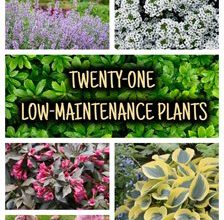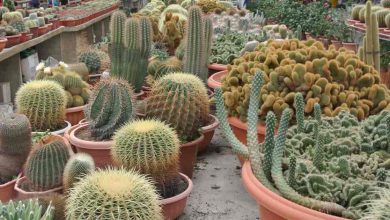Differences between pests, diseases and weeds
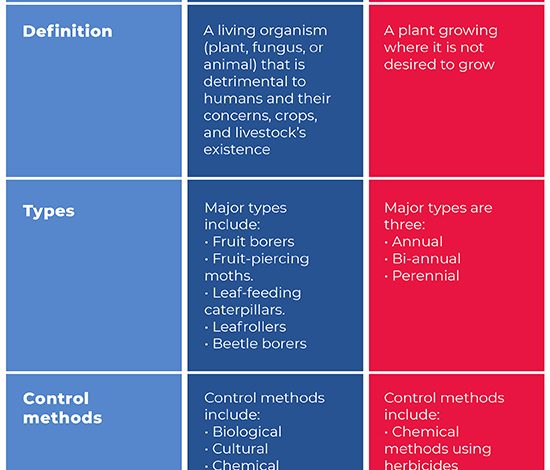
With the arrival of spring and summer, crops can be affected by pests, diseases and weeds, since good conditions make plants an ideal environment to live and reproduce.
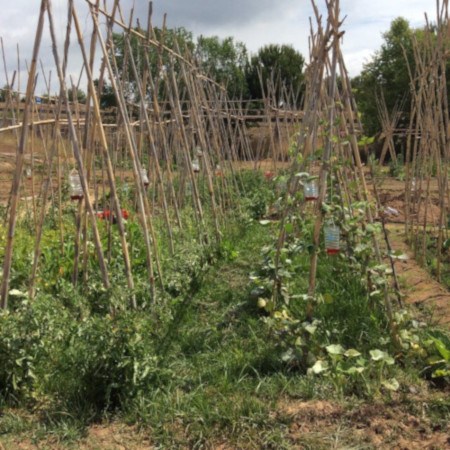
In this post we will see the main differences between pests, diseases and weeds and what are the control methods that we must follow to eliminate them.
Differences between Pests, Diseases and Weeds
The concept of plague is related to the existence of organisms in plants (such as arachnids, rodents, insects, molluscs…) in concentrations higher than they can withstand. It is important to control pests to avoid possible economic damage that they may cause, which will result in a decrease in production.
These pests can be introduced when climatic conditions are favorable for their development and their natural enemies do not act effectively. Another option is that they may be native species that have adapted favorably to crops and these become susceptible to attack.
But not all insects are harmful to plants. Many are beneficial insects, such as natural enemies of pests or pollinators such as bees to form the fruit, and some are even predators of harmful insects.
Plant diseases are negative alterations caused by microorganisms, that is, by fungi, viruses and bacteria that are inappreciable by the human eye. It is for this reason that they are more difficult to diagnose than insect pests. They are characterized by a wide variety of symptoms, such as moldy coatings, wilting, scabbing, black spots, rust or rot.
Weeds or weeds are unwanted plants that will interfere with the development of crops because both will compete for the use of space, nutrients, water and light. As is logical, these weeds will cause great economic losses in addition to reducing yields and quality by reducing the efficiency of fertilization and irrigation in crops.
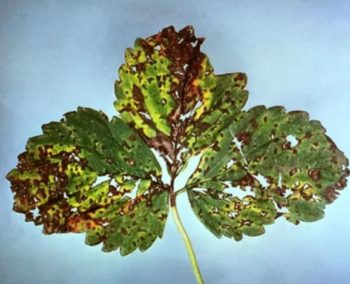
Pest, disease and weed control methods
Once we have learned to differentiate between pests, diseases and weeds, we must know how to control them.
Currently there is sufficient knowledge of most of the parasites, insects, fungi, viruses and bacteria that affect our orchards to prevent their damage.
In organic gardens, the use of insecticides, fungicides or any other synthetic chemical product to control pests, diseases and weeds is prohibited, so it is best to use integrated control with methods such as the ones we will see below.
pest control
The first thing we must know to stop a plague is to know it, its characteristics and its habits. Pests in the orchard are easier to identify because the agent causing the damage is clearly observed. In the post common garden and orchard insects you can find the main pests of garden plants.
We must assess whether the pest is really causing a serious problem or if, on the contrary, it is found in relatively low concentrations. The latter is important, as is the case with the aphid. If the aphid is found on the plant in very low concentrations, it attracts beneficial insects for the garden, such as ladybugs, which, as we have previously mentioned, will favor pollination. If we are in the case of a plague that is causing damage to our garden, we must proceed as follows:
- Assessment of whether agricultural tasks are being carried out correctly. For example, excess or lack of irrigation or fertilization, lack of sunshine, etc. If they are not carried out properly, we are causing a weakening of the plant that makes it more susceptible to attack by insects. An example of this is the appearance of a high population of aphids.
- Manual elimination of insects: this is only done if the garden is very small, as is the case with terrace gardens, balconies, rooftop gardens that are currently becoming very fashionable in cities.
- Elimination of damaged parts of plants, such as stems and leaves so that the pest is not transferred to the rest of the plant.
- Treatments with ecological products: potassium soap or neem oil. In the post Natural insecticides, 10 pesticides for the organic garden, we review the main organic preparations to eliminate undesirable insects.
Disease Control
To avoid diseases, it would be necessary to act preventively by adding good organic fertilizers. For example, earthworm humus and other organic fertilizers such as nettle extract, to strengthen the plants in our organic garden and make them less susceptible to attack by microorganisms.
If the plants are finally affected, we must remove the infected parts (leaves and stems). Sometimes you even have to remove the entire plant to avoid spreading to neighboring plants.
In the post on the main diseases of garden plants, some of the diseases that attack vegetables are detailed and how to control these diseases caused by fungi, bacteria, nematodes…
weed control
Weed control is the practice that takes the longest in the orchard. They can reach the orchard by the wind, the birds, by seeds… and they have negative effects because they compete with the plants, they can give a feeling of abandonment and they are refuges for pests and diseases.
To avoid its presence, some techniques to apply would be:
- Solarization: consists of “cooking” the soil to kill weed seeds.
- Anti- weed meshes: a mesh is spread over the ground that does not let the weeds out.
- Mulching: consists of covering the soil with different materials to make it difficult for the seeds to get light and for them to germinate.
- To avoid the appearance of spontaneous weeds, do not irrigate in areas of bare land.
- Pull out weeds before they bloom and drop seeds.
- Rotation of garden crops year after year.
In the post on how to control weeds in an ecological way you will find more details on how to end this problem.
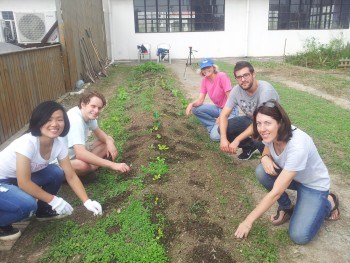
References
- Banfield-Zanin JA, Rossiter JT, Wright DJ, Leather SR, Staley JT (2012). Predator mortality depends on whether its prey feeds on organic or conventionally fertilized plants. Biological Control, 63, 56–61.
- Caballero-López, B., Bommarco, R., Blanco-Moreno, JM, Sans, FX, Pujade-Villar, J., Rundlöf, M., Smith, HG (2012). Aphids and their natural enemies are differently affected by habitat features at local and landscape scales. Biological Control, 63, 222–229.
- Villenave-Chasset, J., (2017). Biodiversité fonctionnelle – Protection des cultures et auxiliaires sauvages. France Agricole, 148 pp.
I hope you have found this general post on pests, diseases and weeds useful. In the category «Pests and diseases» you can find many other articles on the most typical pests of the garden and the most common diseases and how to eliminate them.

![Photo of Blue Flowers: [10 Examples, Care, Characteristics]](https://www.complete-gardening.com/wp-content/uploads/2022/08/blue-flowers-10-examples-care-characteristics-1-390x220.jpg)
![Photo of Ammonium Sulfate: [Concept, Operation and Application]](https://www.complete-gardening.com/wp-content/uploads/2021/06/Que-es-el-sulfato-amonico-390x220.jpg)
